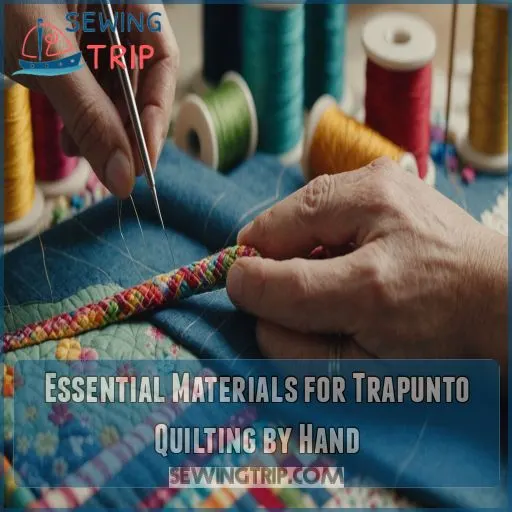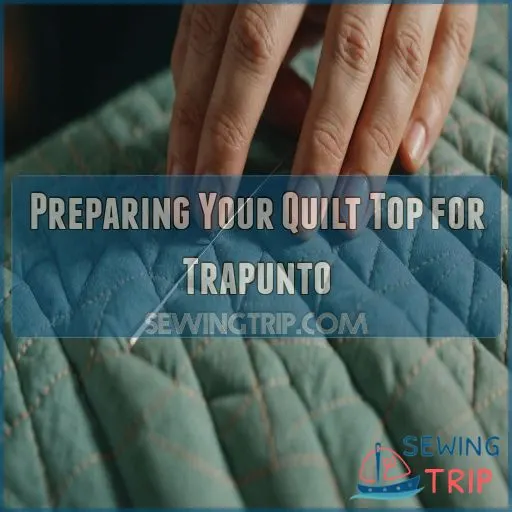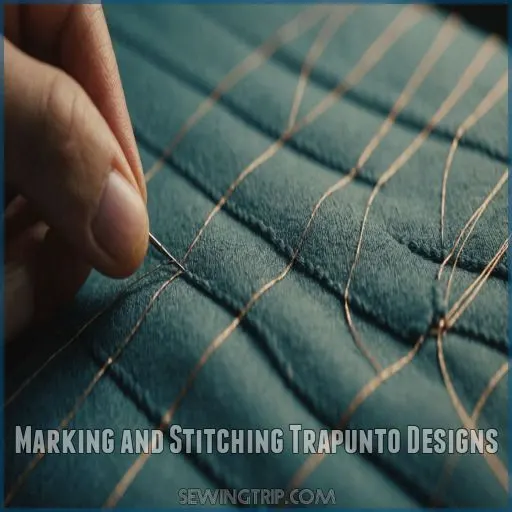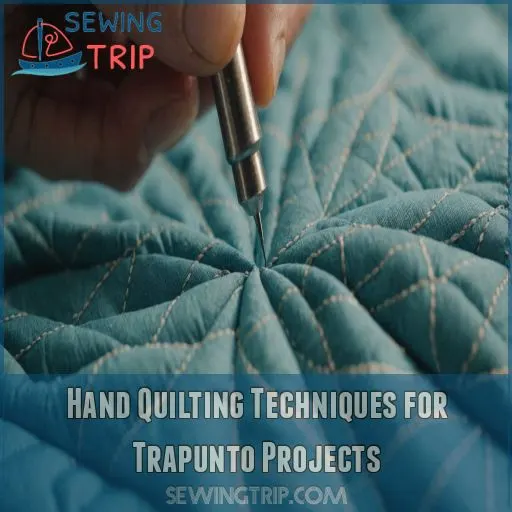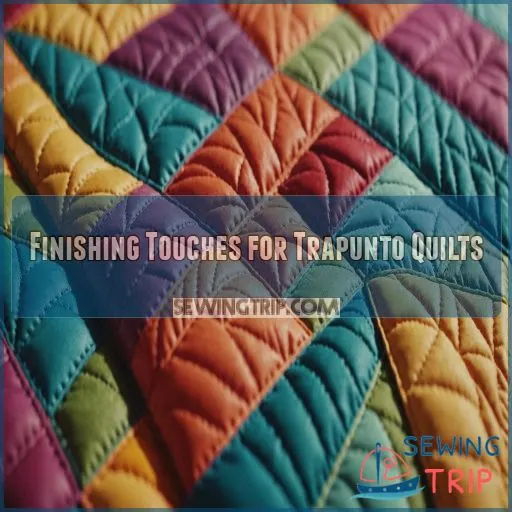This site is supported by our readers. We may earn a commission, at no cost to you, if you purchase through links.
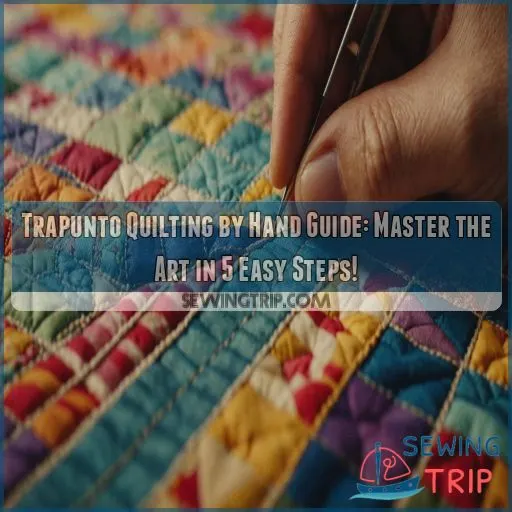 Trapunto quilting by hand is like giving fabric a delightful 3D makeover!
Trapunto quilting by hand is like giving fabric a delightful 3D makeover!
Start by choosing a light, flowing fabric and pairing it with the right batting—cotton for subtlety or wool for a bold puff.
Grab your large yarn needles and trusty Aurifil thread, then get ready to transfer your design using tracing templates or freehand drawing.
As you stitch and stuff, feel that sense of control as you transform flat fabric into art.
Keep your scissors sharp and your humor sharper while snipping excess batting.
Want to learn about finishing touches and make sure your quilt’s glory shines through? Stay tuned for more insights!
Table Of Contents
Key Takeaways
- Choose the right fabric and batting: Imagine your quilt as a cozy sandwich. Opt for lightweight cotton or linen for the fabric and match it with cotton batting for subtlety or wool for that extra puff. You’re setting the stage for a masterpiece that’ll make jaws drop.
- Transfer your designs like a pro: Whether you’re tracing templates, freehand drawing, or using disappearing ink pens, embrace the adventure. Think of it like catching fireflies—once you’ve got those designs on your fabric, it’s time to shine.
- Master the art of stuffing and stitching: Use your trusty needle like a magic wand to transform flat fabric into a 3D wonderland. Avoid overstuffing and puckers by keeping a gentle touch and a keen eye for detail, like a sculptor carving with finesse.
- Finish with flair: The cherry on top of your trapunto quilt is in the final touches. Use a hot iron to erase markings, block your quilt to perfection, and add binding and borders. Treat your quilt like royalty—it’s ready for the spotlight.
Essential Materials for Trapunto Quilting by Hand
Ready to start your trapunto quilting adventure?
Let’s kick things off by gathering all the essential materials you’ll need to create stunning hand-quilted masterpieces with dimension and texture that’ll make your friends go "Wow!" Check out some fabric selection tips for your project!
Choosing the Right Fabric
Imagine your hands gliding over smooth, luxurious fabric as you create a masterpiece. That’s the magic of trapunto quilting!
When choosing fabric, consider these three key factors:
- Weight: Opt for lightweight cotton batiste or similar fabrics.
- Drape: Select fabrics with a soft, flowing drape.
- Texture: Smooth surfaces work best for shadow trapunto techniques.
Selecting Appropriate Batting
Now that you’ve chosen your fabric, let’s talk batting! It’s the unsung hero of your trapunto project. Selecting the right batting can make or break your quilting masterpiece.
Here’s a handy guide to help you choose:
| Batting Type | Loft | Weight | Best For |
|---|---|---|---|
| Cotton | Low | Light | Subtle designs |
| Wool | High | Medium | Bold patterns |
| Polyester | High | Light | Puffy effects |
| Bamboo | Low | Light | Eco-friendly |
Needles and Thread for Trapunto
Choosing the right needles and thread for trapunto is important to make sure your project turns out well.
Your needle selection can make or break your project, so go for a large yarn needle that’ll easily glide through layers.
As for thread, consider these essentials:
- Aurifil 50wt for delicate stitching
- Thicker cotton yarn for stuffing
- Water-soluble thread for temporary basting
Marking Tools for Design Transfer
You’ve got your needles and thread ready, but how will you transfer those beautiful designs? Let’s explore marking tools! They’re your best friends for getting those intricate patterns onto fabric. Check out this handy guide:
| Tool Type | Pros | Cons |
|---|---|---|
| Disappearing ink pens | Easy to use | May fade too quickly |
| Water-soluble markers | Versatile | Can bleed on some fabrics |
| Tracing paper | Great for complex designs | Can be time-consuming |
| Stencils | Consistent results | Limited design options |
| Freehand drawing | Lets you be creative | Requires artistic skill |
Marking tools are essential for transferring designs to fabric.
Disappearing ink pens are easy to use but may fade too quickly.
Water-soluble markers are versatile but can bleed on some fabrics.
Tracing paper is great for complex designs but can be time-consuming, especially when transferring patterns onto fabric.
Stencils provide consistent results but have limited design options.
Freehand drawing lets you be creative but requires artistic skill.
Scissors and Trimming Implements
Before you start making trapunto quilts, let’s talk about your cutting companions.
You’ll need sharp, reliable scissors and trimming tools to bring your designs to life.
Here’s what to keep in your quilting arsenal:
- Fabric shears for precise cuts
- Small, sharp scissors for trimming batting
- Rotary cutter for straight edges
Preparing Your Quilt Top for Trapunto
So you’ve gathered your materials, picturing the quilt as your canvas, and now it’s time to get started with the zeal of a 2018 Island Batik Ambassador gearing up for a creative challenge. Let’s untangle any balloon poodle worries with simple steps.
Choose a lightweight fabric that feels as delightful as a gelato ombre, a blend of softness that dances in your hands.
Create a quilt sandwich starting with a batting that hugs your quilt top like a long-lost friend.
Secure this embrace using a basting method that suits you—be it pins that hold like a steadfast ally or a spray that adheres like warm sunshine on a cool morning.
This prep sets the stage for your masterpiece.
Marking and Stitching Trapunto Designs
Bring your inner artist to life and make your quilt designs pop with trapunto!
Grab your trusty needle and thread, and let’s explore the world of stitching raised, dimensional patterns that will make your quilts truly stand out.
Transferring Designs to Fabric
Getting your quilt top ready is half the battle, now let’s bring those designs to life! Tracing templates, freehand drawing, or even using a projector transforms your cloth canvas. Digital printing is another trick up your sleeve. Don’t let those designs be elusive; capture them with creativity. It’s like catching fireflies—once you snare them, the glow’s all yours!
Basic Trapunto Stitching Techniques
Now that you’ve got your design transferred, it’s time to play with the needle and thread.
Using different trapunto stitch variations, like backstitch or running stitch, can introduce character to your quilt.
Focus on needle placement tips; make sure it glides effortlessly, guiding the stuffing thread types smoothly.
Hand quilting tools are like superheroes, saving the day when you’re stitching trapunto for beginners!
Creating Raised Areas With Stuffing
Plunge into trapunto by threading those stitches with a variety of stuffing types!
Control yarn thickness to dictate just how lofty your design pops.
Dabbling with different stitching densities?
Keep your fabric tension balanced to avoid puckers!
Embrace the puff and let creativity soar!
Securing Stuffing in Place
With your trapunto design marked and the batting inserted, it’s time to secure that fluffy stuffing in place.
Here’s how:
- Use a large, blunt-tipped needle to gently push the yarn through the backing, creating small loops.
- Avoid pulling too tight – you want the stuffing to stay plump and defined.
- Knot the thread on the back to keep everything in place.
Voila, your trapunto is ready to shine!
Trimming Excess Batting
Once your stuffing is snug, it’s time to trim the excess batting.
Imagine you’re a sculptor, delicately carving away to reveal your masterpiece.
Use sharp trimming tools for precision cuts along the stitched lines, mindful of batting thickness.
Don’t rush!
Avoid snipping the quilt top.
Engage your inner artist while respecting safety precautions—no need to lose a finger!
Hand Quilting Techniques for Trapunto Projects
Mastering hand quilting techniques for trapunto projects can feel like a workout for your fingers, but it’s all about finding the rhythm with each stitch.
Let’s tackle the challenge of quilting patterns, tension, and working with those thicker layers, ensuring your trapunto pops with personality and charm!
Choosing Quilting Patterns
So, you’ve nailed stitching designs, now let’s choose quilting patterns that’ll bring your trapunto to life.
Consider simple geometric patterns if you’re just dipping your toes, or complex floral motifs for a real showstopper.
Love spontaneity? Free-motion quilting lets your creativity flow like a jazz solo!
Tension Control in Hand Quilting
Maintaining the right thread tension is really important when hand quilting your trapunto masterpiece.
Experiment with different needle sizes to find the sweet spot – too tight and your fabric may pucker, too loose and your stitches will be uneven.
Pay close attention to the weight of your fabric and quilt layers, adjusting as needed for a smooth, professional finish, like you might do when using Fairfield Poly-Fil Extra-Loft Batting.
Maintaining Consistency in Stitch Size
Finding the right stitch size in trapunto is as comforting as a cup of hot cocoa on a chilly day.
Focus on even stitch flow to keep your work smooth.
Remember:
- Stitch-length practice to get a feel for consistency.
- Needle size impact on hand tension and bobbin problems.
- Stitch spacing tips to fish out errors before they surface, like evaluating throat space for your projects.
You’ve got this!
Working With Thicker Layers
Feeling daunted by trapunto’s thicker layers? Imagine a cozy sandwich: layer choice is key!
Thicker batting density means adjusting your stitch length and needle size. Opt for a heavier thread weight to avoid snapping.
It’s like wrangling a stubborn burrito—patience is essential! Mastering these steps means your puffy design pops, without leaving you in stitches!
Finishing Touches for Trapunto Quilts
You’re almost there, and your trapunto quilt is ready for those perfect finishing touches!
From removing stubborn markings to adding beautiful borders, let’s make sure your masterpiece is photo-ready and won’t be mistaken for your dog’s new blanket.
Removing Temporary Markings
Once you’ve completed the intricate trapunto stitching, it’s time to remove those pesky temporary markings.
No need to fret – this step is a breeze! Simply grab your trusty iron, give it a good sizzle, and watch those lines disappear like magic.
For any stubborn marks, a few spritzes of water-soluble solution will do the trick.
Voila, your trapunto masterpiece is ready to shine!
- Use a hot iron to remove disappearing ink lines.
- Spritz water-soluble solution on any remaining marks.
- Admire your hard work – the trapunto is ready to dazzle!
Blocking the Finished Quilt
Imagine this: finishing touches, and your masterpiece needs a spa day.
Use blocking tools for even tension; think of it like giving your quilt a little chiropractic adjustment.
Carefully pull each edge to match the quilt size, then use steam ironing to coax it into shape.
This step helps your quilt look its best.
Adding Binding and Borders
Wrapping up your trapunto quilt masterpiece with binding and borders is like crowning a king!
Choose fabric that complements your quilt, explore binding types, and play with border styles.
Use sewing techniques that feel as comfy as old jeans, ensuring polished finishing touches.
A well-bound edge? It’s the cherry on top!
Caring for Trapunto Quilts
Taking care of your trapunto quilt means ensuring it’s as snug as a bug in a rug! When washing, treat it gently like a delicate flower:
- Avoid harsh detergents: They’re a quilt’s arch-enemy!
- Store wisely: Ditch sunlit spots that can fade those vibrant hues.
- Iron cautiously: Iron upside down to keep the puffiness pristine!
Showcasing Your Trapunto Masterpiece
Your trapunto masterpiece deserves the spotlight! Snap some stunning photos to showcase its intricate details and dimensional beauty. Share your creation on social media – quilting groups and friends will be in awe. Consider entering it in local quilt shows or community exhibits to inspire others. Why not open an online shop and sell your one-of-a-kind trapunto quilts? The possibilities are endless!
Your trapunto masterpiece deserves the spotlight! Snap some stunning photos to showcase its intricate details and dimensional beauty.
Share your creation on social media – quilting groups and friends will be in awe.
Consider entering it in local quilt shows or community exhibits to inspire others.
Why not open an online shop and sell your one-of-a-kind trapunto quilts? The possibilities are endless!
Frequently Asked Questions (FAQs)
How to do trapunto quilting by hand?
Learn the art of trapunto quilting by hand!
You’ll create stunning, dimensional designs by carefully inserting plump yarn through the backing – just be mindful not to overstuff.
It’s a rewarding technique that adds wow-factor to any quilt.
What is the difference between trapunto and quilting?
Trapunto gives your quilt a 3D flair by adding stuffing to certain areas, creating puffy designs.
Quilting stitches layers together for a flat texture, and can be used to hold fabric layers together before final sewing.
Think of trapunto as giving your quilt some attitude and drama!
What is the trapunto technique?
Imagine breathing life into a quilt with trapunto, a technique that raises areas using extra stuffing.
You’ll make your designs pop and create stunning textures.
It’s like giving your quilt a delightful 3D effect!
What does trapunto mean in English?
Like a fluffy cloud in the sky, "trapunto" in English refers to a quilting technique where certain areas are stuffed to create a raised, puffy effect.
It adds texture and dimension, making your quilt designs pop!
How do you prevent puckering during stuffing?
Don’t let puckering cramp your style!
Gently nudge the fabric threads back together after each trapunto pass.
You’ll have a smooth, puffy design that’s sure to turn heads.
Easy peasy!
What types of fabric are best for trapunto?
Think of fabric like the canvas of your masterpiece.
Opt for cotton or linen, which are sturdy yet supple, to allow trapunto’s puffiness to pop.
Avoid thin, drapey materials—they’re sneaky puckering culprits, stealing your quilt’s thunder.
How can trapunto quilting be used in clothing?
Spice up your wardrobe by adding trapunto quilting to jackets or dresses.
It’s like giving your clothes a 3D makeover, making patterns pop.
Imagine wearing a garden or sculpted motifs—fresh, unique, and totally you!
What are the best tools for cutting batting?
For cutting batting, you’ll find these two besties handy: sharp fabric scissors for precision and an electric rotary cutter for speed.
They’ll turn your batting adventures into a cut above the rest!
How does shadow trapunto differ from traditional trapunto?
You’re in for a real treat! Shadow trapunto takes the classic technique up a notch.
Instead of bulky stuffing, it uses a single layer of batting to create a subtle, shadowy effect.
It’s a modern twist that adds depth and dimension to your quilts.
Conclusion
Imagine your trapunto quilt—a masterpiece in fabric—ready to dazzle hearts and cozy up homes.
With this Trapunto Quilting by Hand Guide, you’ve journeyed from picking the perfect materials to crafting those stunning raised designs.
Armed with newfound skills, you can now embrace each stitch, bringing dimension and charm to your creations.
Let your quilt tell its story, a blend of artistry and patience, where every puff becomes a reflection of your creative flair.
So thread that needle and get quilting!

